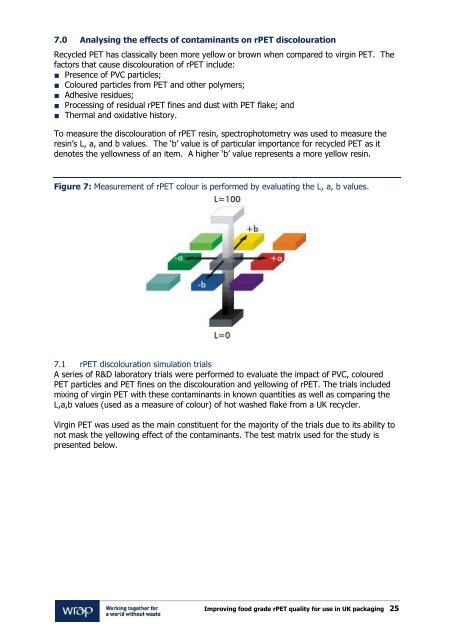rPET Quality Report
Create successful ePaper yourself
Turn your PDF publications into a flip-book with our unique Google optimized e-Paper software.
7.0 Analysing the effects of contaminants on <strong>rPET</strong> discolouration<br />
Recycled PET has classically been more yellow or brown when compared to virgin PET. The<br />
factors that cause discolouration of <strong>rPET</strong> include:<br />
• Presence of PVC particles;<br />
• Coloured particles from PET and other polymers;<br />
• Adhesive residues;<br />
• Processing of residual <strong>rPET</strong> fines and dust with PET flake; and<br />
• Thermal and oxidative history.<br />
To measure the discolouration of <strong>rPET</strong> resin, spectrophotometry was used to measure the<br />
resin‟s L, a, and b values. The „b‟ value is of particular importance for recycled PET as it<br />
denotes the yellowness of an item. A higher „b‟ value represents a more yellow resin.<br />
Figure 7: Measurement of <strong>rPET</strong> colour is performed by evaluating the L, a, b values.<br />
7.1 <strong>rPET</strong> discolouration simulation trials<br />
A series of R&D laboratory trials were performed to evaluate the impact of PVC, coloured<br />
PET particles and PET fines on the discolouration and yellowing of <strong>rPET</strong>. The trials included<br />
mixing of virgin PET with these contaminants in known quantities as well as comparing the<br />
L,a,b values (used as a measure of colour) of hot washed flake from a UK recycler.<br />
Virgin PET was used as the main constituent for the majority of the trials due to its ability to<br />
not mask the yellowing effect of the contaminants. The test matrix used for the study is<br />
presented below.<br />
Improving food grade <strong>rPET</strong> quality for use in UK packaging 25



